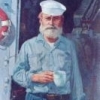Another log entry I found!
Jeff, Alistair, Bob, Jay and Elia, many thanks for the warm welcome and kind words! As promised, here are some pictures of my dories. This first photo is of 2 stacked dories on the skids. They are made to look like they have been knocked about a bit as these are work boats and would have seen some rough handling in their day. There are minor differences in things like the rails to give each an identity beyond the number painted on the bow. I didn't want them to look like carbon copies of each other. This stack is just placed on deck for the photo, it hasn't been installed yet.
I used the jig that came with the kit to make the dories. I found that the sides had to shortened by 1/8" (cut from the aft end, not the forward end) to make things work. I started assembly by edge gluing the P&S sides at the bow and holding them together with my fingers while the glue set up. This gave me a piece that looks like the letter "V". Next I got the sides clamped against the jig using the 8 hook shaped pieces held in place with clothes pins. I then pushed the floor into place. I had made a note of where the center cleat would be and marked the floor on P&S sides. Once in place I used a drop of CA glue to hold things in position and gave the glue time to dry (the spot of glue will be hidden by the batten). Once the glue was dry I turned the whole thing over and put tiny drops of CA glue all along the perimeter where the floor and sides meet, these acted like tiny liquid spot welds. Again, I gave the glue time to dry before I moved on. When the sides were securely attached to the floor I put in the transom. By putting the glue on from the bottom I avoided those shinny spots that show up when you paint over CA glue. With the hull now complete I started work on the interior. I dry fit the cleats and once I had their fit the way I wanted it I drilled the holes in them to allow water to flow between sections. With the cleats installed I glued on all the battens. Next came the thwart supports. I soaked them in water for awhile to make them a little more pliable then glued them in place. I cut the thwarts to fit and glued them in place. The rail was harder to get into place because although I soaked it the wood still wanted to spring back. Then I remembered something I learned at a meeting of the Ship Model Society of NJ. Chuck Passaro gave a demo of how to bend wood and make it hold its shape. I put a piece of paper over the drawing of the dory and traced the outline of the rail. I took that and laid it on a scrap piece of wood. After wetting the rail I used a small spring clamp to clamp one end of the rail on top of the tracing. I then slowly and gently bent the rail to conform to the tracing. I then clamped the other end to the board. The trick is to use heat to dry the wood while it is clamped into the shape you want. Once it is dry (and has cooled) you can remove the clamps and the wood will retain its shape! With the rail now bent to the correct shape I painted the outside edge the same deep midnight blue that I used for the hull of the ship. When the paint was dry I applied a coat of Wipe-On-Poly to both sides and the top. When all that was dry I glued the rails into place. I drilled holes in the transom and the bow and then threaded .6mm tan Morope through. The two loops of rope are used to hoist the dory out of the stack when they are needed for fishing. This is what a finished dory looks like. This single dory will be displayed off the ship at the height of the waterline, probably on a brass rod coming up from the base that the ship will be mounted on.
Each dory has a bunch of gear in it. I've seen photos of fishermen in these dories and many times they had to sit on the rails with their legs intertwined in the thwarts to hold themselves in. My dories are equipped with a coil of .6mm beige rope, 2 oars, two buckets with rope handles (one with fishing line coiled in it, the other empty) and a marker buoy. The inside of the dory is painted with a color called dirty concrete which is a sickly green/tan combo that looks just right for a fishing boat. The outside is painted aged white. The floor of the dory is stained with a deep red oak which nicely simulates blood stained wood (fish blood, not fisherman blood). The number painted on the side is not meant to look like it came out of a factory but more like something a fisherman would have painted using whatever brush was handy. To make the yellow less glaring it is aged with walnut stain applied in a haphazard way. Over all I'm pretty happy with the outcome. This next photo is a shot looking down on a stack. You can see the oars, buoys, buckets and coiled rope. Before this assembly gets attacked to the deck I will load more oars, buckets, etc. As much gear as possible was stored in the stacked dories to save room on deck.
That's it for now. Next up is deck furniture but I am still working out how I want to build these items.
